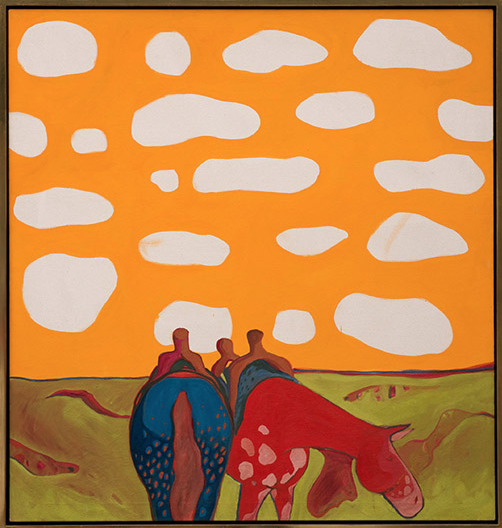Teach This Poem is a weekly series featuring a poem from our online poetry collection, accompanied by interdisciplinary resources and activities designed to help K-12 teachers quickly and easily bring poetry into the classroom.

The following activities and questions are designed to help your students use their noticing skills to move through the poem and develop their thinking about its meaning with confidence, using what they’ve noticed as evidence for their interpretations. Read more about the framework upon which these activities are based.
- Warm-up (quick write and pair share): Listen to a clip from Bob Dylan’s song “All the Tired Horses.” Write down words that you notice or words that stand out. Share with a partner.
- Before Reading the Poem (noticing and pair share): Look carefully at the painting “All the Tired Horses” by T. C. Cannon. This painting was inspired by the song you just heard. With your partner or tablemates, discuss what is happening in the painting. Look again. What else do you notice?
- Reading the Poem: Read the poem “All the Tired Horses in the Sun” by Joy Harjo silently. Notice the words and phrases that jump out at you, then think about what you noticed as you annotate the poem.
- Listening to the Poem (enlist two volunteers to read the poem aloud): Listen as the poem is read aloud twice, and write down any additional words and phrases that jump out at you. Call back the lines that you like by saying these lines aloud with your group.
- Small-group Discussion: Share what you noticed in the poem with your partner and another pair of students. (Teachers, share with students that this poem was commissioned in response to the T. C. Cannon painting.) Based on the details you just shared with your small group, what connections can you make between the poem and painting? In what ways are they similar? Different?
- Whole-class Discussion: (Teachers, if you haven’t already introduced repetition, now might be a good time to do so.) The poem relies heavily on repetition. Which repeated phrases seem to stick in your mind? Why? Why are the horses referred to as “tired”? How might the poem be different if “tired” was not in the poem, or if another adjective was used? What might these horses represent?
- Extension for Grades 7-8: As you learned earlier, the poem was inspired by a painting. This practice is called ekphrastic poetry, where poets respond to a piece of art in writing. Now, you get to do the opposite. Read the poem “Remember” by Joy Harjo. Draw an image inspired by the poem that includes words and/or phrases from the poem. Write a paragraph explaining how your image relates to the poem, or write your a new poem inspired by your own image.
- Extension for Grades 9-12: Read the poem “Remember” by Joy Harjo. Design a poster that incorporates one to four lines of the text into an image that somehow celebrates the art of poetry. (Teachers, now might be a good time to show students the twelve finalists from last year’s National Poetry Month contest. Please encourage students to submit their posters to this year’s contest, which closes on October 25. They can find full guidelines here.)
More Context for Teachers: The Academy of American Poets invites high school students in the United States to enter artwork to be considered for the April 2020 National Poetry Month poster, which will feature lines of poetry from U.S. Poet Laureate Joy Harjo’s “Remember.” This year’s contest will be judged by renowned graphic memoirist Alison Bechdel and former U.S. Poet Laureate Juan Felipe Herrera. The deadline for submissions is October 25, 2019. Read the full guidelines.
